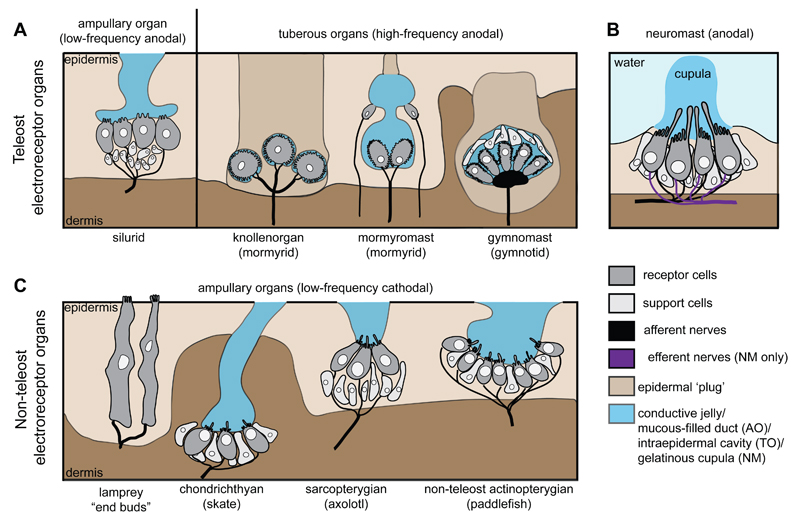Fig. 1.
Schematics illustrating the range of lateral line organ morphologies (not to scale). (A) Teleost ampullary organs (e.g. silurid, based on Northcutt et al., 2000), which respond to low-frequency anodal stimuli, contain electroreceptor cells with short, sparse microvilli, located at the base of mucous-filled ducts that open to the surface. Tuberous organs, which respond to high-frequency anodal stimuli, are morphologically varied but the electroreceptor cells (which have many microvilli) are generally located within an intraepidermal cavity plugged by epidermal cells. Both types of mormyrid tuberous organs (knollenorgan and mormyromast; adapted from Jørgensen, 2005) and a gymnotid tuberous organ (gymnomast; adapted from Cernuda-Cernuda and García-Fernández, 1996) are shown. (B) Neuromast receptor cells, which are mechanosensory but can also respond to large anodal stimuli, have a single cilium flanked by a stepped array of microvilli (the “hair bundle”). The cilia and hair bundles of all the receptor cells in the neuromast are encased together in a gelatinous cupula in contact with water. Unlike electroreceptors, which only receive afferent innervation, neuromast hair cells receive both afferent and efferent innervation. (C) Examples of non-teleost electroreceptor organs, which all respond to low-frequency cathodal stimuli: lamprey "end buds" containing multiple electroreceptor cells, each with multiple microvilli but no cilia (adapted from Jørgensen, 2005), and chondrichthyan (e.g. skate), sarcopterygian (e.g. axolotl) and non-teleost actinopterygian (e.g. paddlefish) ampullary organs, whose electroreceptor cells generally have a single cilium and variable numbers of microvilli. AO, ampullary organ; NM, neuromast; TO, tuberous organ.

